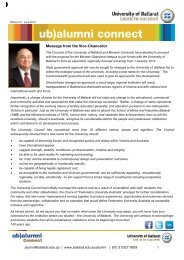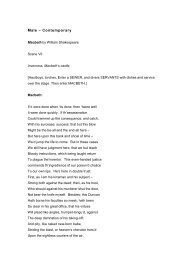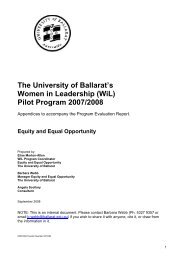Policy without (much) pain - University of Ballarat
Policy without (much) pain - University of Ballarat
Policy without (much) pain - University of Ballarat
- No tags were found...
Create successful ePaper yourself
Turn your PDF publications into a flip-book with our unique Google optimized e-Paper software.
<strong>Policy</strong> <strong>without</strong> (<strong>much</strong>) <strong>pain</strong>11. Planning a policy projectA policy project is a project like any other, and should be planned in the same way. This meansensuring sufficient resources are available and setting a realistic timeline for the work.The very first step in planning is to inform yourself about the institution’s policy developmentprocess (if you aren’t already well aware <strong>of</strong> this). Who is responsible for centralmanagement/coordination <strong>of</strong> institutional policy? You should contact them to let them know aboutyour project and seek their advice. What process is required in the policy on policies or policydevelopment procedures? Do you need to obtain formal approval for the project from someone,or from a committee? What tools and templates are you required to use? Is there an institutionalglossary <strong>of</strong> terms and definitions you should use?When planning your project, start with the proposed dates <strong>of</strong> implementation and committee orexecutive approval, and work backwards. Consider whether staff need to be freed from otherduties for this project – do other targets in the policy developers’ work plans need to be relaxed?If a large number <strong>of</strong> policies need development/review, are new staff positions required? Here iswhere senior management engagement with policy may be useful.Will the policy require new information technology systems if it is to be implemented? Will itinvolve changes to existing IT systems? For example, if an academic progress policy is beingsubstantially amended, and you have an IT system for managing academic progress applicationsand the resulting communications, the changes may require months <strong>of</strong> work for the IT arearesponsible. The work will need to be included in the schedule <strong>of</strong> IT project work well in advance.Your thinking about IT systems should include planning to monitor compliance with the policy,after it is approved, via corporate data systems. For example, if you are going to introduce a newadmissions policy, will you be able to assure the quality <strong>of</strong> admission decisions by what isrecorded on the student management system? How is the basis <strong>of</strong> admission decisions currentlyrecorded, and do more details need to be captured? Do reports <strong>of</strong> the data in the admissionsfields <strong>of</strong> the database need to be developed?If the resources/time-frame are too tight, consider moving the implementation/approval dateslater. Include in the time-frame a realistic period for legal advice on the drafts, and inform thelegal <strong>of</strong>fice in advance <strong>of</strong> when you will be bringing the drafts to them, so they can plan this intotheir own work schedule.It may be appropriate to have separate policy approval and implementation dates to provideadequate time for communication and preparation, and/or where a transition period is necessary.For example, introduction <strong>of</strong> an English language entry requirement may not be able to takeeffect for several years, if students are currently enrolled in programs at other institutions in the~ 19 ~
















